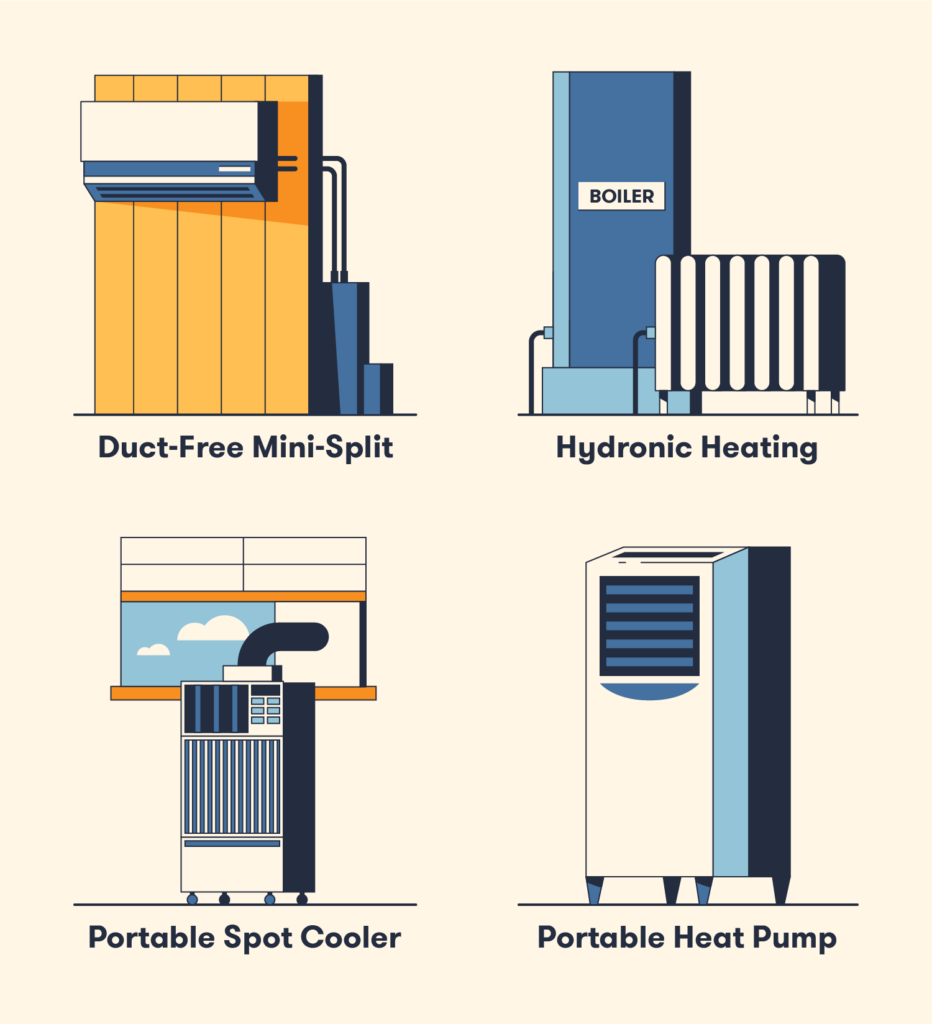
Heating, ventilation, and air conditioning (HVAC) systems play a vital role in creating comfortable and healthy indoor environments across various types of buildings, including industrial, commercial, residential, and institutional spaces. HVAC systems achieve this by adjusting and modifying outdoor air conditions to match the desired indoor conditions of occupied spaces.
Moreover, the distribution system of HVAC plays a critical role in delivering the conditioned air to different parts of the building. This distribution system varies based on factors like refrigerant type and delivery method. Common distribution methods include air handling equipment, fan coils, air ducts, and water pipes, each tailored to meet specific building requirements efficiently.
Basic components of an HVAC system: The main parts of an HVAC system that ensure thermal comfort and indoor air quality are:
- Mixed-air plenum and outdoor air control
- Air filter
- Supply fan
- Exhaust or relief fans and air outlet
- Outdoor air intake
- Ducts
- Terminal devices
- Return air system
- Heating and cooling coils
- Self-contained heating or cooling unit
- Cooling tower
- Boiler
- Control
- Water chiller
- Humidification and dehumidification equipment.
Types of HVAC System:
There are two types of HVAC systems for commercial buildings that you may install: ducted HVAC systems and ductless HVAC systems.

Ducted vs. Ductless Air Conditioning: In a ducted air conditioning system, there are ducts inside the ceilings and walls of the house. Warmed or cooled air travels through these ducts and is delivered to the rooms via vents. On the other hand, a ductless air conditioning system doesn’t have ducts in the walls to supply conditioned air to each room. Instead, it sends refrigerant to several air handlers or blowers that are installed throughout the residence.
Types of HVAC in House:
In Canadian houses, various HVAC (Heating, Ventilation, and Air Conditioning) systems are commonly used to maintain comfortable indoor environments. Here are some types you might encounter:

- Furnaces: A furnace is the most common heating system in Canada because it’s affordable. It works by pulling in cold air, heating it with fuel, then circulating the warm air through ducts in the home. There are different types:
- Natural Gas Furnace: Uses natural gas to produce heat.
- Electric Furnace: Relies on electricity to warm the air.
- Oil Furnace: Uses fuel oil for heating.
- Propane Furnace: Burns propane, a cleaner fuel, to generate heat.
- Heat Pumps: Heat pumps are gaining popularity for their energy efficiency and environmental benefits. They transfer heat instead of burning fuel, which reduces greenhouse gas emissions. Types include:
- Air-source Heat Pump: Extracts heat from outdoor air
- Ground-source Heat Pump: Collects heat from the ground.
- Ductless Mini-Split Heat Pump: Functions like air-source heat pumps but without ducts.
- Boilers: Boilers are common in Canada and heat water to distribute warmth. Types include:
- Gas Boiler: Ignites gas to heat water.
- Oil Boiler: Similar to gas boilers but uses oil as fuel.
- Electric Boiler: Uses electricity to heat water.
- Electric Baseboard Heating: Electric baseboards offer zone heating by controlling individual room temperatures. They consist of a long device placed along walls, heating air as it passes through. Users can adjust the temperature using a thermostat.
- Fireplaces and Woodstoves: Traditionally used for heating, fireplaces and woodstoves burn firewood or pellets to generate heat. While not as efficient as other systems, they serve as backup heaters during power outages and provide localized warmth.
Types of HVAC in Condo’s:
In Canadian condos, various HVAC (Heating, Ventilation, and Air Conditioning) systems are commonly used to maintain comfortable indoor environments. Here are some types you might encounter:

1. Forced Air Systems: These systems use ductwork to distribute heated or cooled air throughout the condo. They typically include a furnace for heating and an air conditioner for cooling.
2. Ductless Mini-Split Systems: Ideal for condos without existing ductwork, mini-split systems consist of an outdoor unit connected to one or more indoor units. They provide both heating and cooling and offer individual temperature control for different zones within the condo.
3. Heat Pump Systems: Heat pumps are efficient for both heating and cooling by transferring heat between the indoors and outdoors. They can be air-source, ground-source (geothermal), or water-source, depending on the available resources and condo layout.
4. Radiant Floor Heating: Some condos use radiant floor heating systems, where hot water flows through pipes installed beneath the floor, providing consistent and comfortable warmth throughout the space.
5. Hydronic Heating Systems: Similar to radiant floor heating, hydronic systems use water to distribute heat, but they can also utilize radiators or baseboard heaters instead of or in addition to floor heating.
6. Packaged Terminal Air Conditioners (PTACs): Often found in older condo buildings, PTAC units provide both heating and cooling in individual rooms. They are typically installed through exterior walls and are controlled by individual thermostats.
7. Central Boiler Systems: In larger condo complexes, a central boiler system may be used to provide heating and sometimes hot water to multiple units. These systems circulate heated water or steam through pipes to radiators or baseboard heaters in each condo.
The choice of HVAC system in a condo often depends on factors such as the building’s design, size, age, and budget considerations, as well as the preferences of the residents and condo management.
Conclusion: In Canada, HVAC systems are crucial for keeping homes comfortable year-round. They provide heating in the winter and cooling in the summer. To ensure comfort and energy efficiency, homeowners should choose the right system, maintain it regularly, and take advantage of available incentives. As technology advances, we can expect even more efficient and environmentally friendly HVAC options in the future.
For further details or assistance with the real estate in the GTA, feel free to contact
Paul Bendavid
RE/MAX Realtron Realty Inc. Brokerage
Cell: 647-988-7355
Office: +1 905 539 9511
Address: 183 Willowdale Ave, Toronto, Canada

